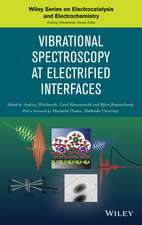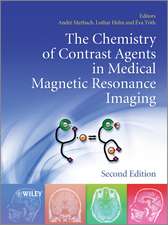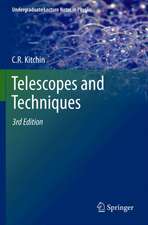X–ray Photoelectron Spectroscopy: An introduction to Principles and Practices
Autor Paul van der Heideen Limba Engleză Hardback – 26 ian 2012
This is presented in a concise yet comprehensive manner and each section is prepared such that they can be read independently of each other, and all equations are presented using the most commonly used units. Greater emphasis has been placed on spectral understanding/interpretation. For completeness sake, a description of commonly used instrumentation is also presented. Finally, some complementary surface analytical techniques and associated concepts are reviewed for comparative purposes in stand–alone appendix sections.
Preț: 630.20 lei
Preț vechi: 685.00 lei
-8% Nou
120.59€ • 125.90$ • 99.80£
Carte tipărită la comandă
Livrare economică 05-19 aprilie
Specificații
ISBN-10: 1118062531
Pagini: 272
Ilustrații: Illustrations
Dimensiuni: 156 x 234 x 17 mm
Greutate: 0.59 kg
Editura: Wiley
Locul publicării:Hoboken, United States
Public țintă
Researchers, developers, technicians in material science, chemistry, physics, surface science lab managers, students, semiconductors, dielectric materials, electronics packaging, thin film and coatings industriesDescriere
The essential reference on X–ray Photoelectron Spectroscopy (XPS) and its practical applications
X–ray Photoelectron Spectroscopy represents the most heavily used of the electron spectroscopies for surface analysis. This book serves as a definitive introduction to this field by providing concise yet comprehensive coverage of all key concepts and then supplying relevant, illuminating examples of real–world applications.
Placing an emphasis on spectral understanding and interpretation, the book includes coverage of topics including: how to interpret the different spectra revealed by XPS; how they are produced and factors that can influence the spectra (including initial and final state effects); as well as how to derive speciation, volume analyzed and how to control this (including depth profiling), along with background substraction and curve–fitting methodologies. With each section standing alone, the text can be read from front to back or treated as a comprehensive resource that researchers, developers, and technicians of all levels can access as needed.
Including review questions to help readers measure their comprehension of the material, as well as a comparative review of some complementary surface analytical techniques and associated concepts, X–ray Photoelectron Spectroscopy is designed to enhance understanding of this rapidly growing field.
Textul de pe ultima copertă
The essential reference on X–ray Photoelectron Spectroscopy (XPS) and its practical applications
X–ray Photoelectron Spectroscopy represents the most heavily used of the electron spectroscopies for surface analysis. This book serves as a definitive introduction to this field by providing concise yet comprehensive coverage of all key concepts and then supplying relevant, illuminating examples of real–world applications.
Placing an emphasis on spectral understanding and interpretation, the book includes coverage of topics including: how to interpret the different spectra revealed by XPS; how they are produced and factors that can influence the spectra (including initial and final state effects); as well as how to derive speciation, volume analyzed and how to control this (including depth profiling), along with background substraction and curve–fitting methodologies. With each section standing alone, the text can be read from front to back or treated as a comprehensive resource that researchers, developers, and technicians of all levels can access as needed.
Including review questions to help readers measure their comprehension of the material, as well as a comparative review of some complementary surface analytical techniques and associated concepts, X–ray Photoelectron Spectroscopy is designed to enhance understanding of this rapidly growing field.
Cuprins
FOREWORD xi
PREFACE xiii
ACKNOWLEDGMENTS xv
LIST OF CONSTANTS xvii
1 INTRODUCTION 1
1.1 Surface Analysis 1
1.2 XPSESCA for Surface Analysis 5
1.3 Historical Perspective 6
1.4 Physical Basis of XPS 7
1.5 Sensitivity and Specificity of XPS 10
1.6 Summary 11
2 ATOMS, IONS, AND THEIR ELECTRONIC STRUCTURE 13
2.1 Atoms, Ions, and Matter 13
2.1.1 Atomic Structure 14
2.1.2 Electronic Structure 15
2.1.2.1 Quantum Numbers 16
2.1.2.2 Stationary–State Notation 18
2.1.2.3 Stationary–State Transition Notation 20
2.1.2.4 Stationary States 21
2.1.2.5 Spin Orbit Splitting 23
2.2 Summary 25
3 XPS INSTRUMENTATION 27
3.1 Prerequisites of X–ray Photoelectron Spectroscopy (XPS) 27
3.1.1 Vacuum 28
3.1.1.1 Vacuum Systems 32
3.1.2 X–ray Sources 35
3.1.2.1 Standard Sources 37
3.1.2.2 Monochromated Sources 39
3.1.2.3 Gas Discharge Lamps 41
3.1.2.4 Synchrotron Sources 41
3.1.3 Electron Sources 42
3.1.3.1 Thermionic Sources 42
3.1.4 Ion Sources 43
3.1.4.1 EI Sources 43
3.1.5 Energy Analyzers 44
3.1.5.1 CMA 46
3.1.5.2 CHA 46
3.1.5.3 Modes of Operation 47
3.1.5.4 Energy Resolution 48
3.1.6 Detectors 49
3.1.6.1 EMs 50
3.1.7 Imaging 52
3.1.7.1 Serial Imaging 52
3.1.7.2 Parallel Imaging 54
3.1.7.3 Spatial Resolution 56
3.2 Summary 59
4 DATA COLLECTION AND QUANTIFICATION 61
4.1 Analysis Procedures 61
4.1.1 Sample Handling 62
4.1.2 Data Collection 64
4.1.3 Energy Referencing 65
4.1.4 Charge Compensation 69
4.1.5 X–ray and Electron–Induced Damage 71
4.2 Photoelectron Intensities 72
4.2.1 Photoelectron Cross Sections 74
4.2.2 The Analyzed Volume 75
4.2.2.1 Electron Path Lengths 76
4.2.2.2 Takeoff Angle 79
4.2.3 The Background Signal 80
4.2.4 Quantification 81
4.3 Information as a Function of Depth 83
4.3.1 Opening up the Third Dimension 84
4.3.1.1 AR–XPS and Energy–Resolved XPS 84
4.3.1.2 Sputter Depth Profiling 87
4.4 Summary 97
5 SPECTRAL INTERPRETATION 101
5.1 Speciation 101
5.1.1 Photoelectron Binding Energies 102
5.1.1.1 The Z + 1 Approximation 106
5.1.1.2 Initial State Effects 107
5.1.1.3 Final State Effects 118
5.1.1.4 The Auger Parameter 133
5.1.1.5 Curve Fitting 135
5.2 Summary 138
6 SOME CASE STUDIES 141
6.1 Overview 141
6.1.1 Iodine Impregnation of Single–Walled Carbon Nanotube (SWNT) 142
6.1.2 Analysis of Group IIA IV Metal Oxides 145
6.1.3 Analysis of Mixed Metal Oxides of Interest as SOFC Cathodes 151
6.1.4 Analysis of YBCO and Related Oxides/Carbonates 156
6.2 Summary 163
APPENDICES 167
APPENDIX A PERIODIC TABLE OF THE ELEMENTS 169
APPENDIX B BINDING ENERGIES (B.E.XPS OR B.E.XRF) OF THE ELEMENTS 171
B.1 1s–3s, 2p–3p, and 3d Values 171
B.2 4s–5s, 4p–5p, and 4d Values 175
APPENDIX C SOME QUANTUM MECHANICS CALCULATIONS OF INTEREST 177
APPENDIX D SOME STATISTICAL DISTRIBUTIONS OF INTEREST 181
D.1 Gaussian Distribution 182
D.2 Poisson Distribution 182
D.3 Lorentzian Distributions 183
APPENDIX E SOME OPTICAL PROPERTIES OF INTEREST 185
E.1 Chromatic Aberrations 186
E.2 Spherical Aberrations 186
E.3 Diffraction Limit 186
APPENDIX F SOME OTHER SPECTROSCOPICSPECTROMETRIC TECHNIQUES OF INTEREST 189
F.1 Photon Spectroscopies 191
F.1.1 IR, RAIRS, ATR, and DRIFTS 191
F.1.2 Raman, SERS, and TERS 192
F.1.3 EDX and WDX 193
F.1.4 XRF and TXRF 194
F.2 Electron Spectroscopies 195
F.2.1 UPS 195
F.2.2 AES 195
F.2.3 EELS, REELS, and HREELS 196
F.3 Ion Spectroscopies Spectrometries 196
F.3.1 SIMS 196
F.3.2 TAP 197
F.3.3 Ion Scattering Methods 197
APPENDIX G SOME MICROSCOPIES OF INTEREST 199
G.1 SEM 200
G.2 HIM 201
G.3 TEM 201
G.4 SPM (AFM and STM)–Based Techniques 202
APPENDIX H SOME REFLECTIONDIFFRACTION TECHNIQUES OF INTEREST 205
H.1 XRD 206
H.2 GID 206
H.3 XRR 207
H.4 LEED 207
H.5 RHEED 207
TECHNIQUE ABBREVIATIONS LIST 209
INSTRUMENT–BASED ABBREVIATIONS 213
GLOSSARY OF TERMS 215
QUESTIONS AND ANSWERS 221
XPS VENDORS 229
REFERENCES 233
INDEX 237






